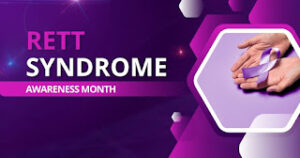Rett Syndrome: Understanding, Awareness, and Hope
Rett Syndrome is a complex and rare genetic neurological disorder that primarily affects girls and often becomes evident after six to 18 months of age. Its impact on cognitive, motor, and communicative abilities is profound, resulting in challenges that persist through life. Rett Syndrome Awareness Month, observed in October, aims to raise global awareness, foster understanding, and support research and treatments for those affected.

Rett Syndrome Awareness month |
What is Rett Syndrome?
Rett Syndrome is caused by mutations in the MECP2 gene on the X chromosome, which regulates numerous functions related to brain development. The disorder occurs almost exclusively in females, as males with the mutation typically do not survive infancy due to the essential role of the MECP2 gene in brain function. Rett Syndrome affects about 1 in 10,000 live female births worldwide and results in various symptoms, including:
- Loss of purposeful hand use: Affected individuals often develop repetitive hand movements such as wringing, washing, or tapping.
- Impaired language skills: Most individuals with Rett Syndrome lose their ability to speak.
- Motor and balance difficulties: Walking and sitting may become challenging or impossible.
- Seizures and respiratory problems: These are common among individuals with Rett Syndrome and significantly impact quality of life.
The disorder’s progression includes an initial period of typical development followed by a plateau and gradual loss of acquired skills.
Symptoms and Stages of Rett Syndrome
Rett Syndrome progresses through four distinct stages:
- Early Onset Stage (6-18 months): Symptoms are subtle, including reduced eye contact, delays in motor skills, and slight delays in growth.
- Rapid Destruction Stage (1-4 years): Children may experience a significant loss of purposeful hand use, social engagement, and language abilities.
- Plateau Stage (Preschool to Adulthood): Symptoms stabilize, and some may see improvements in social interaction and communication.
- Late Motor Deterioration Stage (Adolescence onwards): Motor disabilities worsen, with increased muscle rigidity, scoliosis, and reduced mobility.
Rett Syndrome Awareness Month and Campaign Color
Rett Syndrome Awareness Month takes place every October. During this month, various organizations, families, and individuals worldwide engage in activities to raise awareness, promote education, and advocate for support.
The campaign color for Rett Syndrome is purple, symbolizing courage and resilience. People are encouraged to wear purple, participate in local events, and use social media to spread awareness.
Diagnosis and Treatment Options
Diagnosing Rett Syndrome involves a combination of genetic testing and clinical evaluations. Since the MECP2 mutation can be identified through DNA tests, many families receive a definitive diagnosis. Although no cure exists, therapeutic options help manage symptoms:
- Physical Therapy and Occupational Therapy: These can aid in maintaining mobility and hand function.
- Speech Therapy: Though most individuals are non-verbal, speech therapy supports communication through alternative methods.
- Medications: These may help control seizures, breathing irregularities, and gastrointestinal issues.
Emerging treatments, including gene therapy and drug interventions targeting MECP2 function, are under research. A prominent area of focus is developing methods to restore MECP2 function or compensate for its absence in affected neurons.
Major Institutions Dedicated to Rett Syndrome Treatment and Research
A number of institutions worldwide are dedicated to researching Rett Syndrome and providing specialized care for affected individuals. Here are some of the leading centers:
Rett Syndrome Research Trust (RSRT)
- Description: The RSRT is a nonprofit dedicated to funding research for a cure.
- Link: RSRT
International Rett Syndrome Foundation (IRSF)
- Description: The IRSF supports research, families, and healthcare providers with resources.
- Link: IRSF
Children’s Hospital Boston, Rett Syndrome Program
- Description: Offers comprehensive care, including genetic testing, neurology, and therapy services.
- Link: Children’s Hospital Boston
Pace Hospitals, India
- Description: A specialized center in India providing awareness, education, and advanced care.
- Link: Pace Hospitals
Monroe Carell Jr. Children’s Hospital at Vanderbilt
- Description: This hospital has a dedicated Rett Syndrome clinic focused on multidisciplinary care.
- Link: Vanderbilt
How to Raise Awareness for Rett Syndrome
Throughout October, individuals and organizations participate in initiatives to bring Rett Syndrome into the spotlight. Here are some effective ways to spread awareness:
- Social Media Campaigns: Share information, stories, and visuals on platforms like Twitter, Facebook, and Instagram.
- Wear Purple Day: Encourage people in your community to wear purple in solidarity.
- Local Events and Fundraisers: Host or attend charity events, such as walks, marathons, or awareness drives.
- Educational Workshops: Collaborate with schools or community centers to educate the public.
- Share Stories and Experiences: Personal narratives from those affected can help others understand Rett Syndrome better.
The Future of Rett Syndrome Research
With ongoing studies and advancements in gene therapy, researchers are optimistic about the potential for future treatments that could restore MECP2 function. By expanding Rett Syndrome research, a cure or effective treatment may eventually become a reality.
Rett Syndrome Awareness Month is a time of reflection, support, and action. With the right resources, support, and ongoing research, we can continue to bring hope and aid to those affected by this disorder.
